Options
Grades Are In - Challenging IKE!
Results have been posted and the coins have been received! (The comments in the Variety/Error field are mine which were edited into the table.)
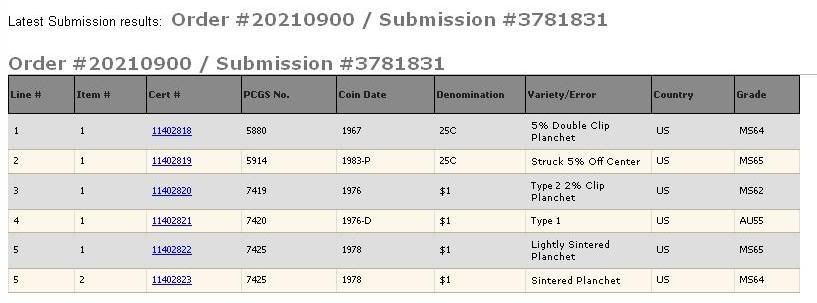
Line 1
Picked this coin up at a San Jose Coin Show for around $15. At the time, I had reported that this was a triple clip but closer examination shows that I confused the Blakeslee Effect opposite the large clip as a third minor clip.
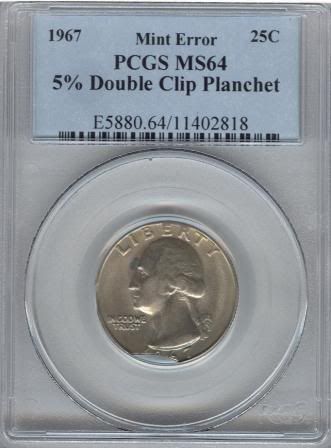 ..
.. 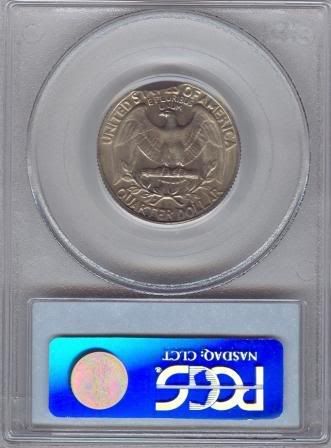
Line 2
I picked this coin up off of eBay before I realized how common these off center strikes actually are for 1983. The real surprise came when I opened the package and 2 coins dropped out! It turns out the auction was for two off center coins so I didn't really pay that much. Something less than $30 but I find that off center strikes have a certain appeal since it's not something that everybody has seen and they make for good conversation.
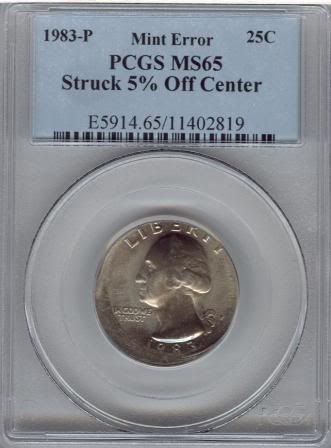 ..
.. 
Line 3
This was probably a waste of money so before fc can jump in, I'll admit it was simply a waste but, I have a softspot for error IKEs and I am working on a full set of clippers. This will fit in nicely. BTW, this was an eBay coin. Very minor clip for a not so minor price and yes I'm a badboy!
 ..
.. 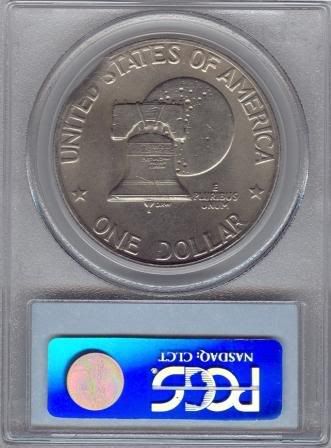
Line 4
This coin is a bit of a challenge and I was hoping that PCGS was up to it but as it turns out, a couple of things got crossed.
First off, the coin was submitted as a Type 2 but they felt the need to change it to a Type 1. I suspect because of the broadness of the lettering but that is due to whatever caused its current condition. Besides, there are other methods of determining a BiCentennial Type when there is any doubt. Primarily, on a Type 1 coin, the U in UNUM, almost lines up directly under the U in PLURIBUS. On the Type 2 coin, the U is not even close to lining up. Second off, the Type 1 lettering on the reverse does not have ANY serif's on the Type 1 coin whereas the Type 2 coin does.
Second off, I submitted it as die trial strike/grease strike through/Grease Filled Die. PCGS gave it neither designation and simply chose to grade it as an AU55. Granted, there is some wear on the coin as it is definitely not BU but I'll be damned if I can understand why the profile does not show the same degree of wear as the edges of the coin. As a matter of fact, the ear and cheek area appear to be BU even though the scan has killed the luster. Since my camera is fried, I cannot photograph it otherwise I would.
Because they slabbed it as a Type 1, the coin will have to go back for correct designation. At that time, I'll see if I can get an explanation on why it wasn't designated at the minimum as a grease strike through. BTW, the rim has very little reeding which I am told can be used to determine if it is a die trial strike. If its sharp then its a grease strike through, if not, then its a die trial strike.
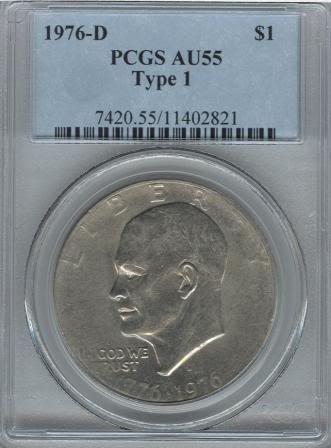 ..
.. 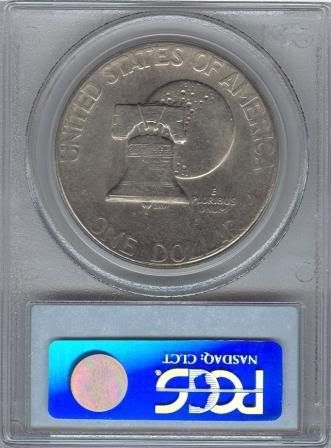
The rim reeding
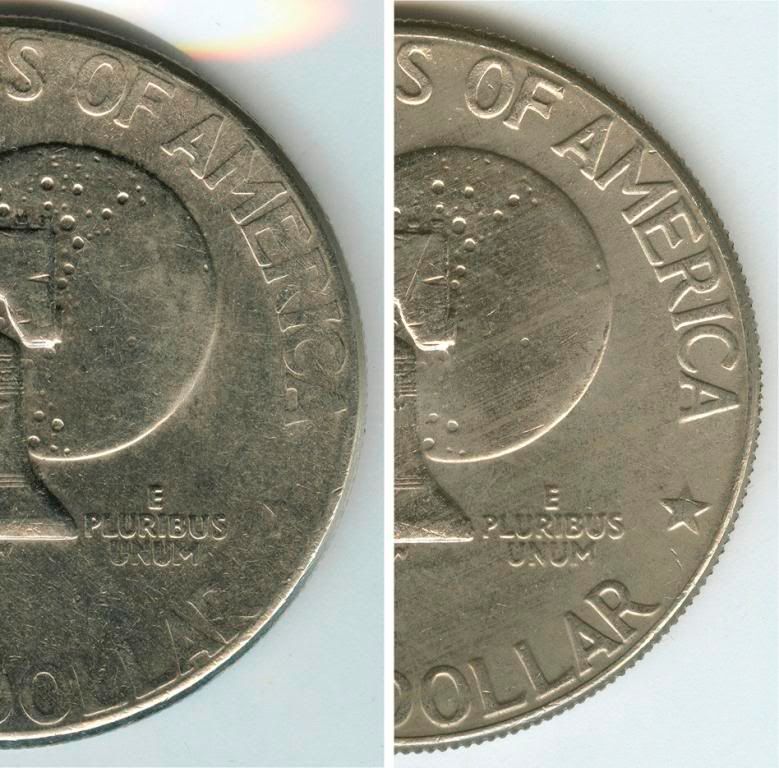
Closeup of Motto showing how much larger the outer letters are than the inner letters. Both in thickness and in heighth. This does not appear to be wear related.

Finally, determining Type 1 and Type 2 Reverses for BiCentennial Coins.
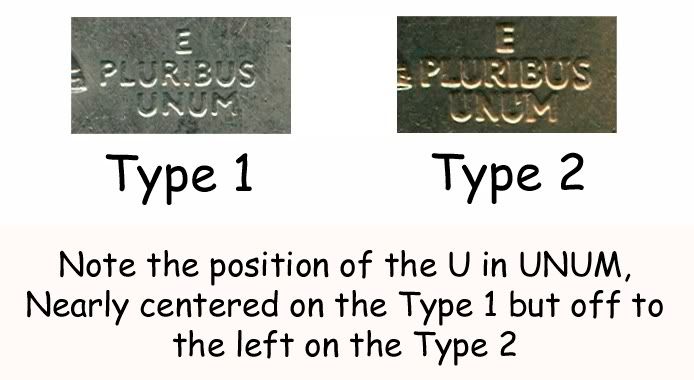
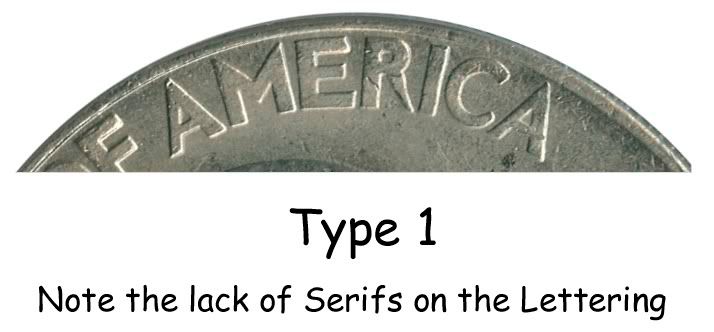
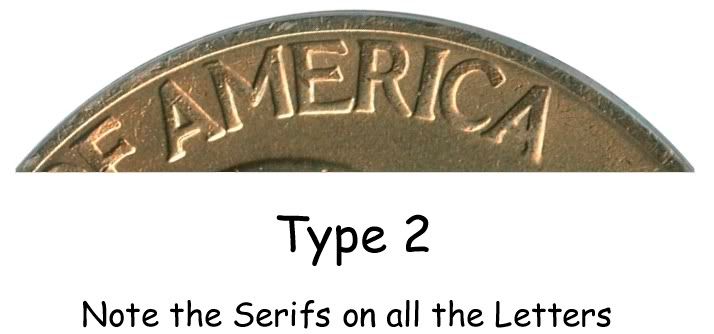
Again, if the coin were truely an AU55 with this much wear, I would expect the wear to be more evenly distributed across the surfaces instead of concentrated on the outer edges.
Line 5a
I can't remember where I came across the tweo coins on Line 5 but it may have been a roll I picked up off of eBay.
After I had purchased an AU55 Type 2 from DLRC, I couldn't help but notice that the coin was very dark. I was informed that it was a sintered planchet which was quite common on Type 2 coins. It was very dark but had some very nice toning on it! I posted that coin in this thread.
To make a long story short, as soon as these popped out, I knew immediatly what they were and put them aside for grading at a later date.
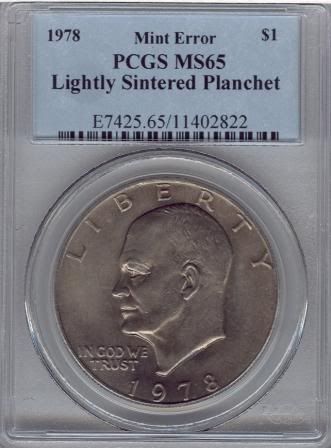 ..
.. 
Line 5b
I'm at a loss as to why the coin above was labeled as "Lightly Sintered" as the two are both sintered, its just that one is much more than the other.
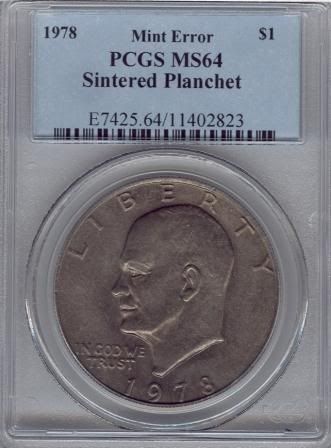 ..
.. 
Of all the coins submitted, I am most pleased with the two 1978's.
Why?
Simple! Its because these were passed over by somebody else in a roll of coins because they just did not know what they were. I find this to be true of nearly all the IKEs in my collection and this is what keeps me going with these. Folks just do not look at them with any real interest which means that there are still some nice treasures out there just waiting to be found in this series which ended close to 30 years ago!

Line 1
Picked this coin up at a San Jose Coin Show for around $15. At the time, I had reported that this was a triple clip but closer examination shows that I confused the Blakeslee Effect opposite the large clip as a third minor clip.
 ..
.. 
Line 2
I picked this coin up off of eBay before I realized how common these off center strikes actually are for 1983. The real surprise came when I opened the package and 2 coins dropped out! It turns out the auction was for two off center coins so I didn't really pay that much. Something less than $30 but I find that off center strikes have a certain appeal since it's not something that everybody has seen and they make for good conversation.
 ..
.. 
Line 3
This was probably a waste of money so before fc can jump in, I'll admit it was simply a waste but, I have a softspot for error IKEs and I am working on a full set of clippers. This will fit in nicely. BTW, this was an eBay coin. Very minor clip for a not so minor price and yes I'm a badboy!
 ..
.. 
Line 4
This coin is a bit of a challenge and I was hoping that PCGS was up to it but as it turns out, a couple of things got crossed.
First off, the coin was submitted as a Type 2 but they felt the need to change it to a Type 1. I suspect because of the broadness of the lettering but that is due to whatever caused its current condition. Besides, there are other methods of determining a BiCentennial Type when there is any doubt. Primarily, on a Type 1 coin, the U in UNUM, almost lines up directly under the U in PLURIBUS. On the Type 2 coin, the U is not even close to lining up. Second off, the Type 1 lettering on the reverse does not have ANY serif's on the Type 1 coin whereas the Type 2 coin does.
Second off, I submitted it as die trial strike/grease strike through/Grease Filled Die. PCGS gave it neither designation and simply chose to grade it as an AU55. Granted, there is some wear on the coin as it is definitely not BU but I'll be damned if I can understand why the profile does not show the same degree of wear as the edges of the coin. As a matter of fact, the ear and cheek area appear to be BU even though the scan has killed the luster. Since my camera is fried, I cannot photograph it otherwise I would.
Because they slabbed it as a Type 1, the coin will have to go back for correct designation. At that time, I'll see if I can get an explanation on why it wasn't designated at the minimum as a grease strike through. BTW, the rim has very little reeding which I am told can be used to determine if it is a die trial strike. If its sharp then its a grease strike through, if not, then its a die trial strike.
 ..
.. 
The rim reeding

Closeup of Motto showing how much larger the outer letters are than the inner letters. Both in thickness and in heighth. This does not appear to be wear related.

Finally, determining Type 1 and Type 2 Reverses for BiCentennial Coins.



Again, if the coin were truely an AU55 with this much wear, I would expect the wear to be more evenly distributed across the surfaces instead of concentrated on the outer edges.
Line 5a
I can't remember where I came across the tweo coins on Line 5 but it may have been a roll I picked up off of eBay.
After I had purchased an AU55 Type 2 from DLRC, I couldn't help but notice that the coin was very dark. I was informed that it was a sintered planchet which was quite common on Type 2 coins. It was very dark but had some very nice toning on it! I posted that coin in this thread.
To make a long story short, as soon as these popped out, I knew immediatly what they were and put them aside for grading at a later date.
 ..
.. 
Line 5b
I'm at a loss as to why the coin above was labeled as "Lightly Sintered" as the two are both sintered, its just that one is much more than the other.
 ..
.. 
Of all the coins submitted, I am most pleased with the two 1978's.
Why?
Simple! Its because these were passed over by somebody else in a roll of coins because they just did not know what they were. I find this to be true of nearly all the IKEs in my collection and this is what keeps me going with these. Folks just do not look at them with any real interest which means that there are still some nice treasures out there just waiting to be found in this series which ended close to 30 years ago!
I decided to change calling the bathroom the John and renamed it the Jim. I feel so much better saying I went to the Jim this morning.
The name is LEE!
The name is LEE!
0
Comments
–John Adams, 1826
Hey Lee,
Nice post.
I really enjoyed reading this and learned stuff to boot.
I look at wheat back Lincoln's the way you look at Ike's.
Searching through a few rolls of Lincoln's is like popping a Valium and lighting a cigar.
While I paid and purchased it slabbed, I got a 5% off center MS66 clad Ike for $275. While this may appear to be a lot, that last MS66 of the same date and grade had sold for $278.... so the off center was free.
I hope one day to put together a registry set of error Ikes.
<< <i>Excellent post Lee! I'm sitting here wondering what is a sintered planchet - how would I know one if I held it in my hand? >>
Sintering is likened to the term 'powder coating' which was very popular in the late 80's and early 90's for car parts. Basically, a powder is applied to the surface of say a wheel and then baked on.
With sintering on coins, a copper powder, which is produced during the manufacturing and processing of planchets, gets baked onto the surface of the planchets especially if the planchet goes through the preminting processes multiple times (like getting stuck in a processing bin). The more times it gets processed, the darker the coin gets.
My first experience with sintered planchets was with a Peace Medal Nickel which appeared lavendar in color right out of the mint sack. I actually ended up with 4 or 5 of these and when I asked, was told it was sintering. Ref Thread)
I've also run across them on the new presidential dollars.
This is easy to spot on the presidential dollars because the surface appears as a dark brown mottling and is uneven. Its a little more difficult to detect on copper nickel clad coins which can sometimes appear black. But, if you encounter one of these directly out of a mint bag or an OBW roll, then 9 times out of 10 its a sintered planchet.
I am in no way an expert in this area but only refer what I have heard and have been told. Perhaps someone else has a better explanation.
The name is LEE!
<< <i>Where in the world do you find these?... very fun to look at!!! >>
Easy, all you have to do is really look at the IKEs. Obviously high grades are at the top of the list but other oddities are there just for the taking but you have to look at them first.
That has been one major problem with Eisenhower Dollars over the years. Folks don't collect them so if a high grade coins shows up or the odd ball clip shows up they'll grab it but anything else is just tossed into the crap pile! I doubt anybody execpt an IKE collector would have given those two 78's a second look. But when I spotted them and their bright coppery brand new edges, I knew immediately that they were sintered planchets.
The one on the right is a 1971-D and not a silver coin.
The one in the middle is a sintered planchet coin.
The name is LEE!
–John Adams, 1826
Someone's having fun and that's a good thing!
"Inspiration exists, but it has to find you working" Pablo Picasso